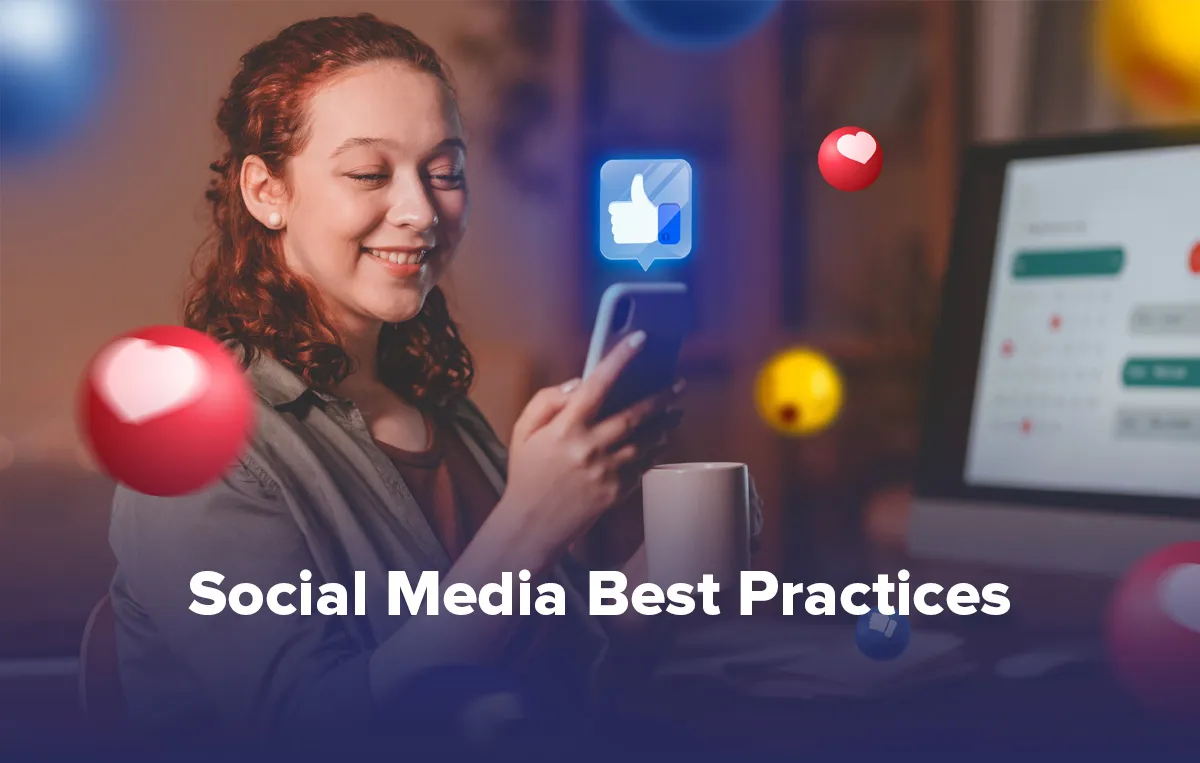You think your social media best practices are cutting-edge? Think again. Maybe what you are doing is already outdated. In 2024, social media is all about adapting and innovating. At once, it is about following trends, and at another, it is about setting new trends.
Do you think you know social media? Think again. Maybe what you know is already gone by the time you read this. In 2024, social media is all about breaking the rules and setting new standards. At once, it is about following trends, and at another, it is about setting new trends.
So where should you start, and what should you do? Social media is an ever-evolving world, and so should your brand’s social media marketing strategy. To support you in making a strong strategy, here’s a blog about the refined and evolved social media best practices. In this, we will not just talk about keeping up but leading the change.
Take it as a quo to throw the old playbook out the window and adapt to the refined practices to grow your brand faster on social media. To prepare you to shake up the social media universe in 2024, here are 19 social media practices to follow to see success along the way.
19 Social Media Best Practices You Need to Know [2024 Edition]
Based on the different stages of a brand’s social media campaigns, here are 19 best practices for social media for planning, content, engagement, execution, innovation, customer services, and much more to keep you on check from start to end.
Best Social Media Practices for Strategic Planning and Analysis
If you begin wrong, there is no hope for correction afterward. Keeping this in mind, here are some best social media practices so you can start strategic planning and analysis on the right foot.
1. Define Goals Linked to Business Objectives
To ensure your efforts contribute to the bigger picture and have clarity and purpose, set social media goals that align with the brand’s business objectives to derive action that matters.
For relevance, you should set these social media goals quarterly or bi-annually at the beginning of strategy-making and planning. With clear goals aligning with business objectives, allocating resources, providing direction, and creating measurable targets becomes possible.
To set achievable goals for your social media, you should:
- Start with identifying business objectives. (Revenue, expansion, awareness, etc.)
- Translate these objectives to social media goals. (Increase sales = boost in conversions)
- Your goals should be S.M.A.R.T (Specific, Measurable, Achievable, Relevant, and Time-Bound)
- Based on goals, set social media metrics and KPIs. (CTR, reach, engagement, etc.)
- Now, you can develop a step-by-step plan to achieve these goals. (Assign tasks, set deadlines, allocate resources)
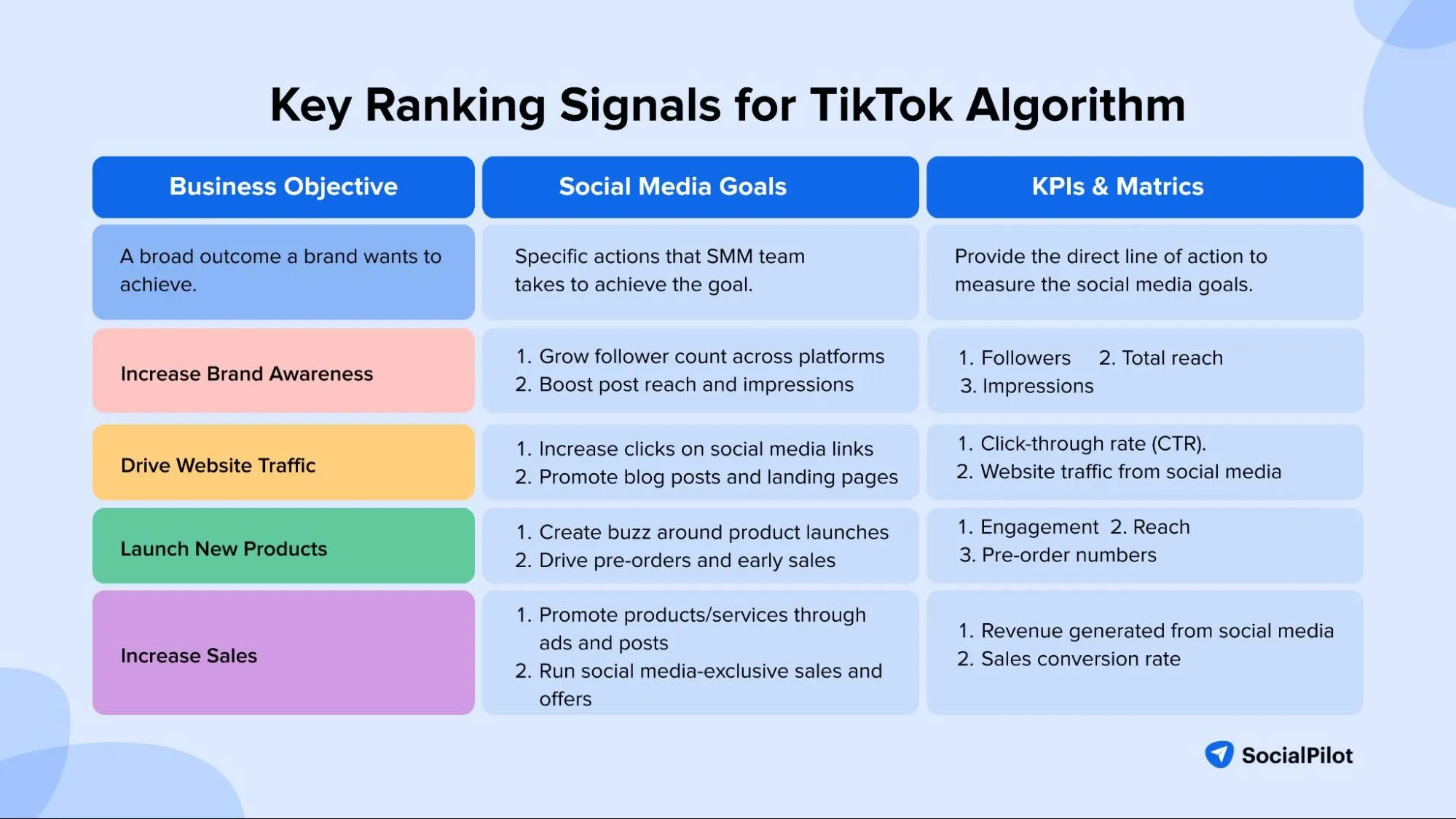
Identifying business objectives and setting social media goals is a process that occurs with key stakeholders during strategy meetings in different quarters.
2. Conduct Regular Competitor Analysis
After setting your goals and objectives for social media, it’s time to analyze your competitors. This keeps you aware of what your competitors are doing and helps you stay ahead of industry trends and improve for better results.
Start by picking a few top competitors from your industry and identifying their strengths and weaknesses. This will help you understand the market and what works and what does not. Even though this process of analyzing your competitor takes place during the initial stage of social media planning, brands often conduct competitor analysis and set their goals to outperform the competitors.
When you know everything about your competitors, you can uncover opportunities for differentiation and stay competitive and innovative by knowing what is trending in your industry.
A simple social media competitor analysis includes the following:
- Identifying a few direct and indirect competitors on social media.
- Analyze their social media content and most successful posts and campaigns.
- Prepare a checklist and measure your brand’s and competitors’ data on different networks.
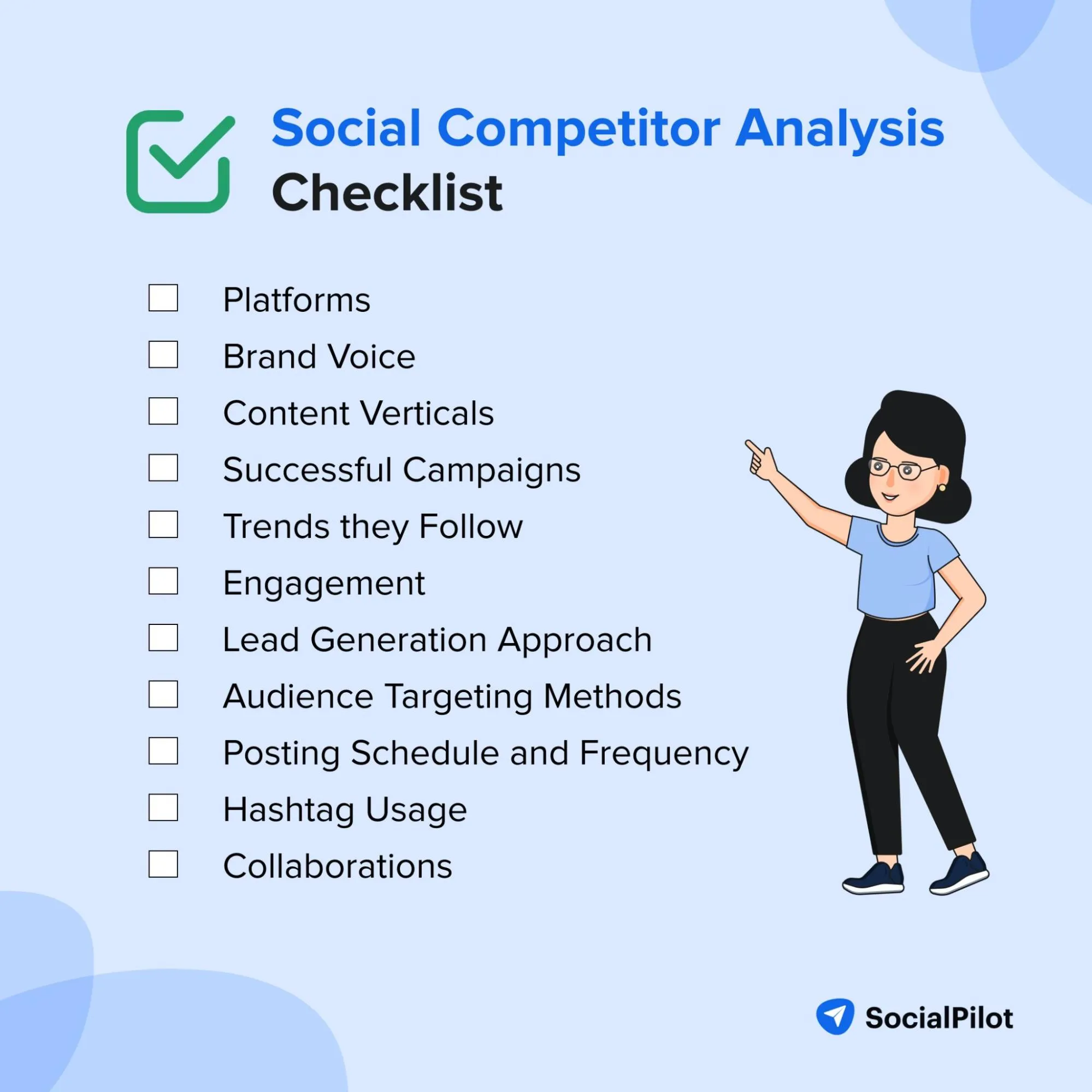
- Based on their engagement and strategy, evaluate gaps and opportunities.
Your brand’s social media team can perform this competitor analysis internally, or you can ask a marketing agency to do it for you.
Competitor analysis is necessary for every growing brand and, even more important, for years-old established enterprises. Even companies like Coca-Cola analyze their competitors regularly (Pepsi and Dr Pepper) to stay ahead and continue as market leaders.
3. Adapt to Algorithm Changes
Predicting your competitor’s next move is not enough; it’s crucial to adapt to any possible social media algorithm changes. If you want your brand to grow on social channels, it’s essential to adapt to these algorithm changes.
Every platform has its own mechanism that determines the visibility and reach of your content. This mechanism impacts how content is prioritized and displayed to users. Social media platforms frequently update their algorithms without any notice. So, to prevent a drop in reach and interaction, you must take action and change your strategy.
How to keep up with social media algorithm changes?
- Read more and stay informed via social media marketing blogs, forums, newsletters, etc.
- Monitor the performance of your social channels to identify any change in engagement metrics that may indicate algorithm changes.
- Adjust your social media strategy as per the algorithm changes along with keeping content standards high.
- To actually understand what algorithm favors, test with experimentation.
This is a quick representation of how social media algorithms of different social channels have changed in 2023 and 2024:
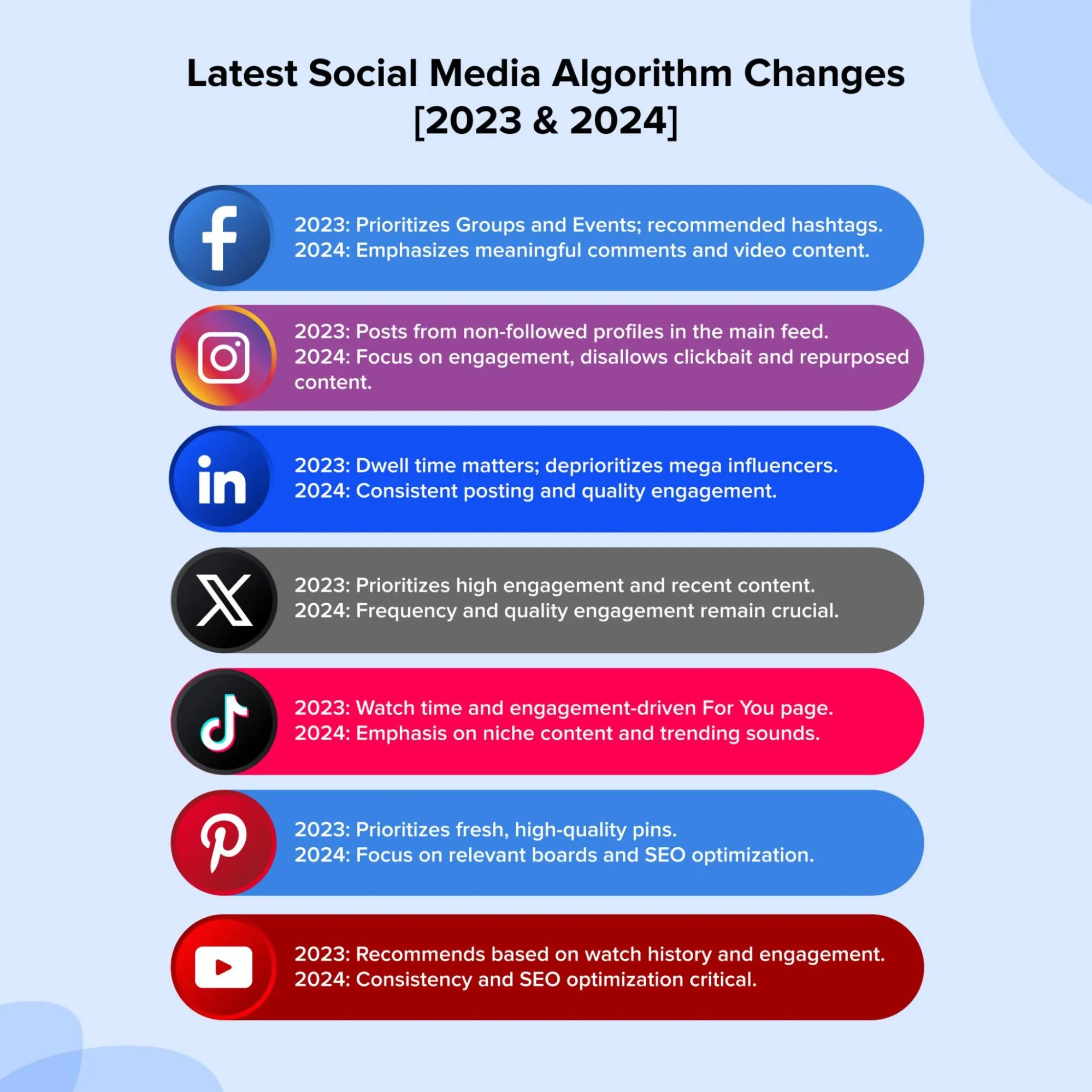
Understanding, decoding, and integrating algorithms should be a daily routine in social media management. To effectively monitor, analyze, and implement these changes in your strategy, you can utilize social media management tools like SocialPilot.
Learn More About How Algorithm Works on Different Social Media Platforms:
4. Implement Analytics Tool
When it comes to planning and strategizing, your brand needs a social media analytics tool that provides insights into your performance and helps in strategic decisions. They let you track, measure, and analyze your brand’s social media performance with data on engagement and content effectiveness.
If you want to have regular insights on what’s working and what’s not to refine your strategy, optimize content, and achieve better results, using a Social Media Analytics Tool like SocialPilot from the beginning of the strategy to monitor the performance will help you stay informed about every minor change.
SocialPilot is a dedicated suite of features with analytics and reporting to enhance data-driven decision-making. With SocialPilot, you get:
- Downloadable Whitelabel Reports
- In-depth Page Analytics
- Priority Report Scheduling
- Reporting Sharing with Clients
- Individual Posts Analytics
- Custom Reports
- Platform Centric KPIs/Metrics
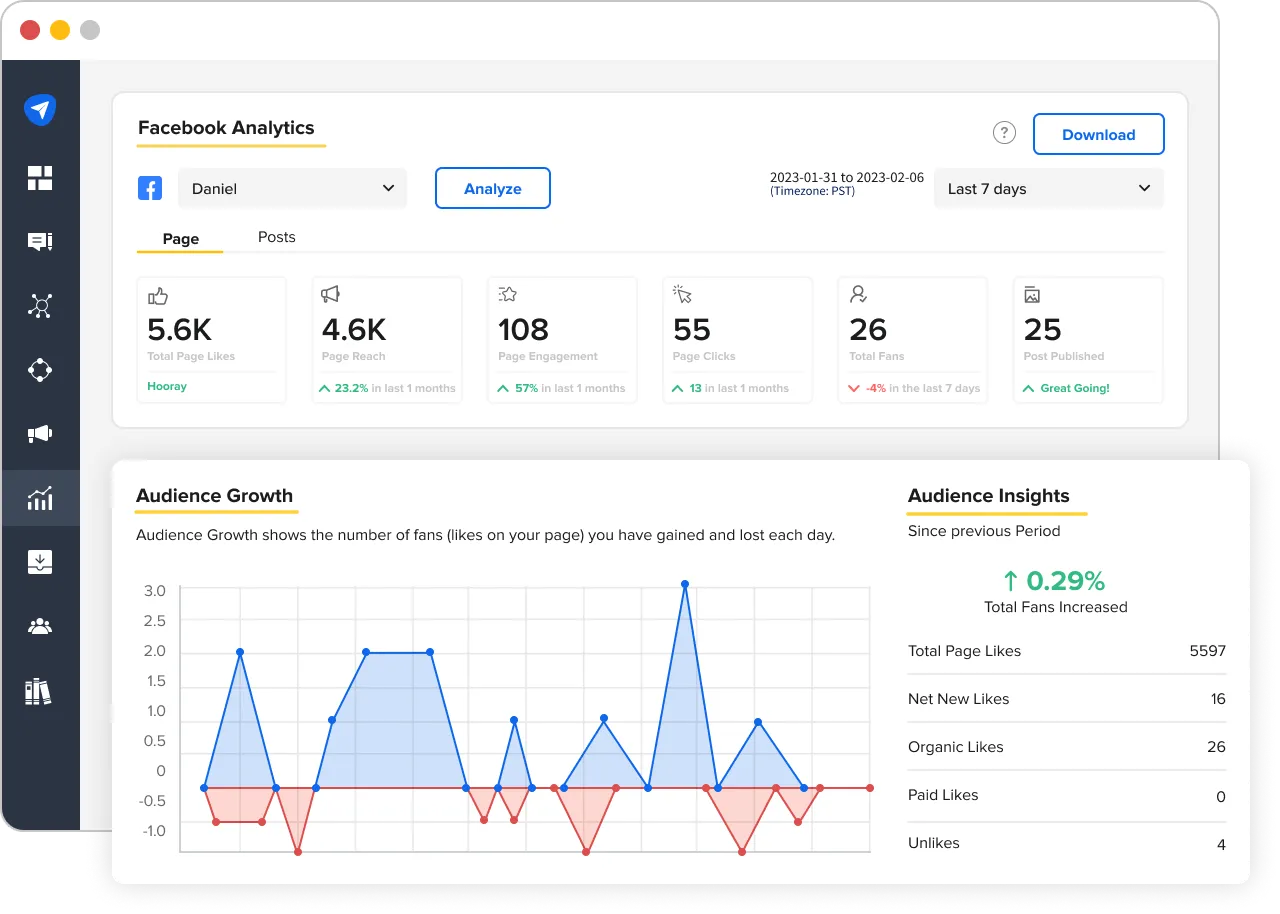
Take a 14-day Free Trial!
Social Media Best Practices for Content Creation and Optimization
Armed with perfect planning and analytics? Now, you can shift your focus to other social media best practices for creating high-quality, relevant creation and optimization. Let’s start with the most trending one: AI.
5. Leverage AI for Content Creation
Using AI for content creation means employing Artificial Intelligence Tools to generate, optimize, and personalize social media content. You can use these tools for generating content ideas, writing captions, and finding relevant hashtags, including the right emojis, etc., specific to your social channel.
Brands use AI for post ideas to reduce time efforts and prepare engaging content. When you start creating social media content, you can integrate an AI tool to streamline creativity.
There are several AI tools in the market, you can choose yours based on your needs. If you are looking for a tool just to generate ideas and content, you can use ChatGPT, Copy.ai, etc. But if you are in need of a holistic tool that can streamline
social media efforts, have AI Assistant, which provides analytics and reporting and also automates your social media, then you can integrate tools like SocialPilot, a 360-degree social media management tool.
Experience the power of AI with the SocialPilot’s Free Caption Generator.
Free AI Instagram Caption Generator
Generate scroll-halting Instagram captions with our AI-powered Instagram Caption Generator.
Here is the Generated Result

Create More for Free!
Get 500 Credits to Generate AI Content!
Since you’re an AI fanatic, we are offering you 500 Free Credits to generate awesome content
on
the AI Assistant of SocialPilot.
6. Focus on Quality Visual & Content
Creating visually high-quality content means focusing more on high-resolution images, videos, and visually appealing graphics. With the increasing effectiveness of interactive content, brands are also including content like polls, quizzes, live streaming, and interactive videos in their lists.
When your content is visually appealing, the chances of it getting shared, remembered and engaged also increase more than any other static post. Keeping visually interactive content as a priority in every campaign and post will keep your feed fresh and aesthetically attractive.
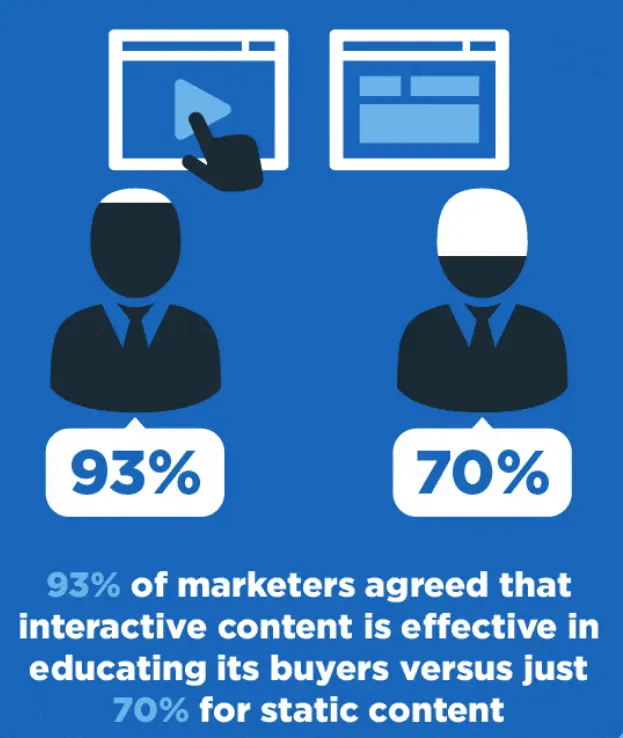
Like every marketer, your brand can also leverage the opportunity and generate high-quality content that is visually appealing and interactive at the same time. Having quality content also means ensuring the assets are within the correct size guidelines for each social channel. So, to achieve top content quality on social media, ensure the following factors:
- Use good quality cameras and editing software, or get your content prepared professionally.
- Develop your own style guide and aesthetic and create your brand’s visual identity, such as color scheme, typography, and image guidelines.
- Use SocialPilot Social Media Scheduler to adjust your graphics for different social media networks before scheduling multiple posts simultaneously.
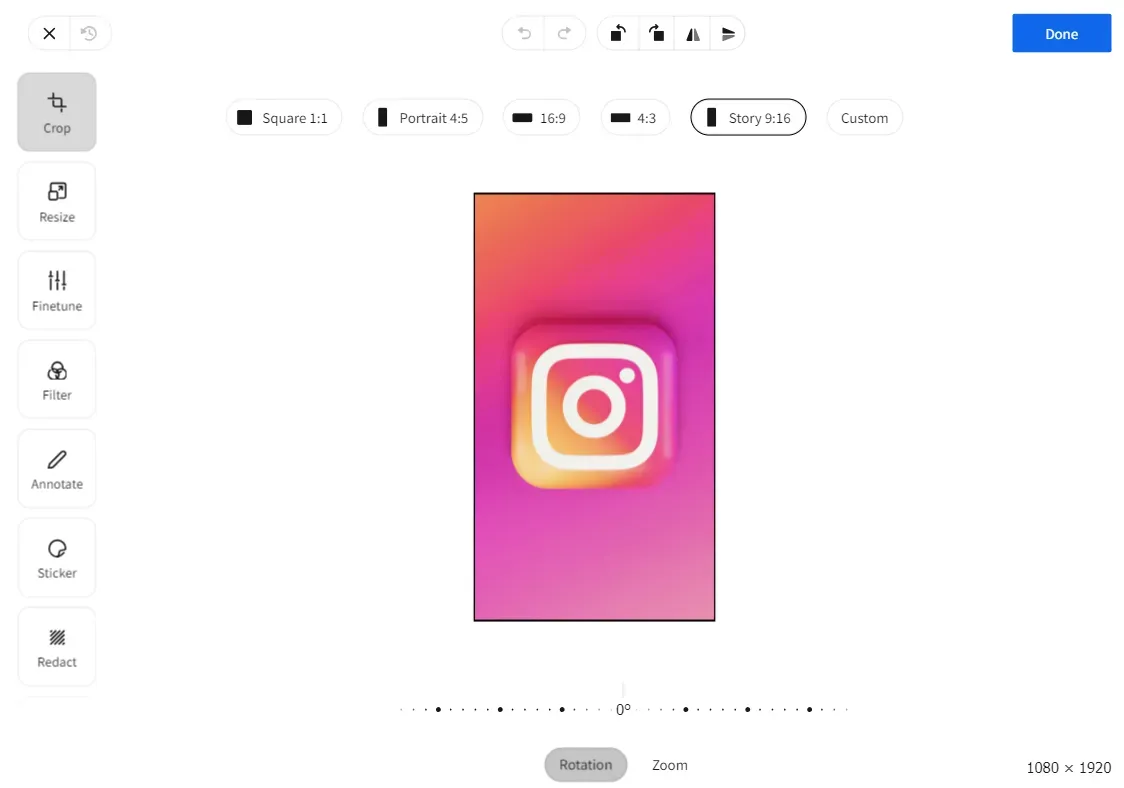
- Use more and more videos to showcase boring content.
Don’t make the mistake of preparing the athletic of your social media and neglecting your website and other digital touchpoints. Prepare a completely aligned brand image across all channels and platforms where your target audience interacts with your brand.
7. Create Content Specific to Social Media Platforms
Preparing your content platform-specific means tailoring your content to fit perfectly as per the vibe, audience, and unique features of each social media platform.
This is one of the social media best practices because each platform has a different format and audience with various expectations from the content. When you design and set your posts as per this preference, you ensure good engagement, reach, and effectiveness on the platform.
Here’s a little peek at the demography and other important elements of different social media platforms.
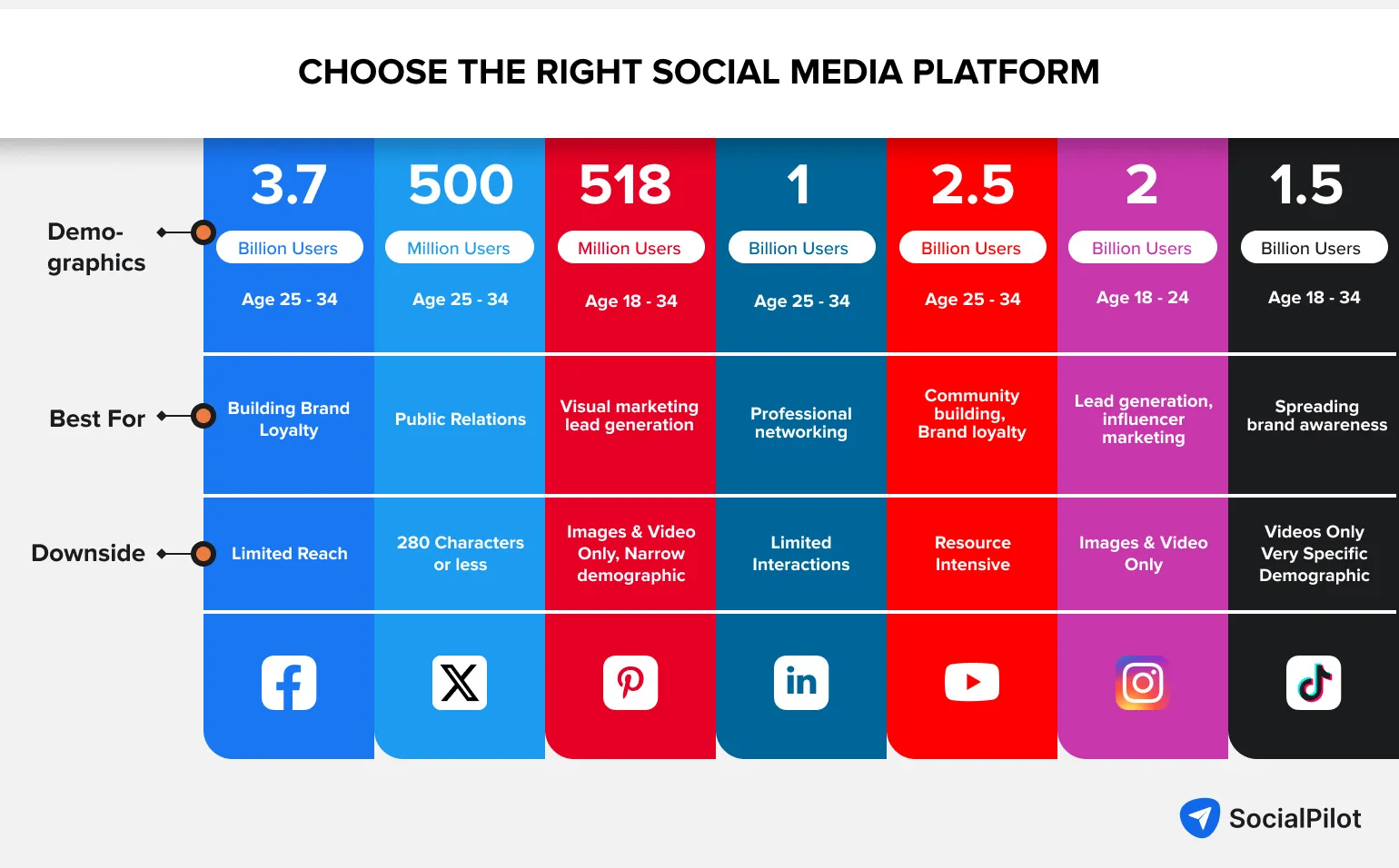
Practicing this across all social media platforms while preparing your content and witness the increase in the engagement and reach it gives you.
8. Practice Ethical Marketing
Ethical marketing is all about promoting your brands with honesty, transparency, and social responsibility. It is also about being true to the process you follow during different stages of marketing, such as using AI tools ethically and focusing on integrity.
Ensuring the well-being of your customers and society and showing them the reality of everything you do will build trust and loyalty. This is one of the social media best practices that enhances your brand reputation and helps you stand out as a frontier.
To stay ethically true during every aspect of your social media process, you can ensure these factors:
- Don’t misguide your audience regarding your product’s features, benefits, and limitations. Claim only the things that you truly provide.
- Stay ethical while utilizing AI for different parts of your social media marketing. Remember that AI is there to help humans and keep things professional.
- Respect your customers’ privacy, and don’t feed their data to others. Be transparent about how you collect and store their data.
- Promote growth and support your users’ growth with you. By participating in their growth, you can give them a reason to trust you.
- Be a socially responsible brand that is all there for sustainability. Sustainability goes a long way.
- Avoid fake reviews, customer interactions, and engagements. Ensure that you only foster genuine relationships.
See how Patagonia has been very transparent about even the most useful inventions of the time, like Dams, and how they are not so useful for nature.

This is how honest you are expected to be on social media, even if you are out for a lost cause.
Social Media Best Practices for Operational Efficiency
In every social media campaign, there are several things to ensure while executing the strategy. There are some social media practices that your brand can implement to maintain operational efficiency.
9. Maintain a Consistent Posting Schedule
Having a consistent posting schedule means two things: sharing posts on social channels a regular intervals and keeping the frequency of those posts optimum. For consistency, you must have a set timeline and a plan to keep your audience hooked to your feed and aware of your brand.
When a brand is consistent with its content on social media, it builds trust, which improves its visibility. It keeps it top of the minds of its followers and helps establish a brand voice. So, develop a posting schedule before you start working on the content strategy and stick to it. You can either use a social media calendar template or employ a social media content calendar tool.
Also, every social platform has its own algorithm and content preference. So, you must also include a separate posting frequency for each one of them. Here’s the recommended frequency you should follow for different social media networks.
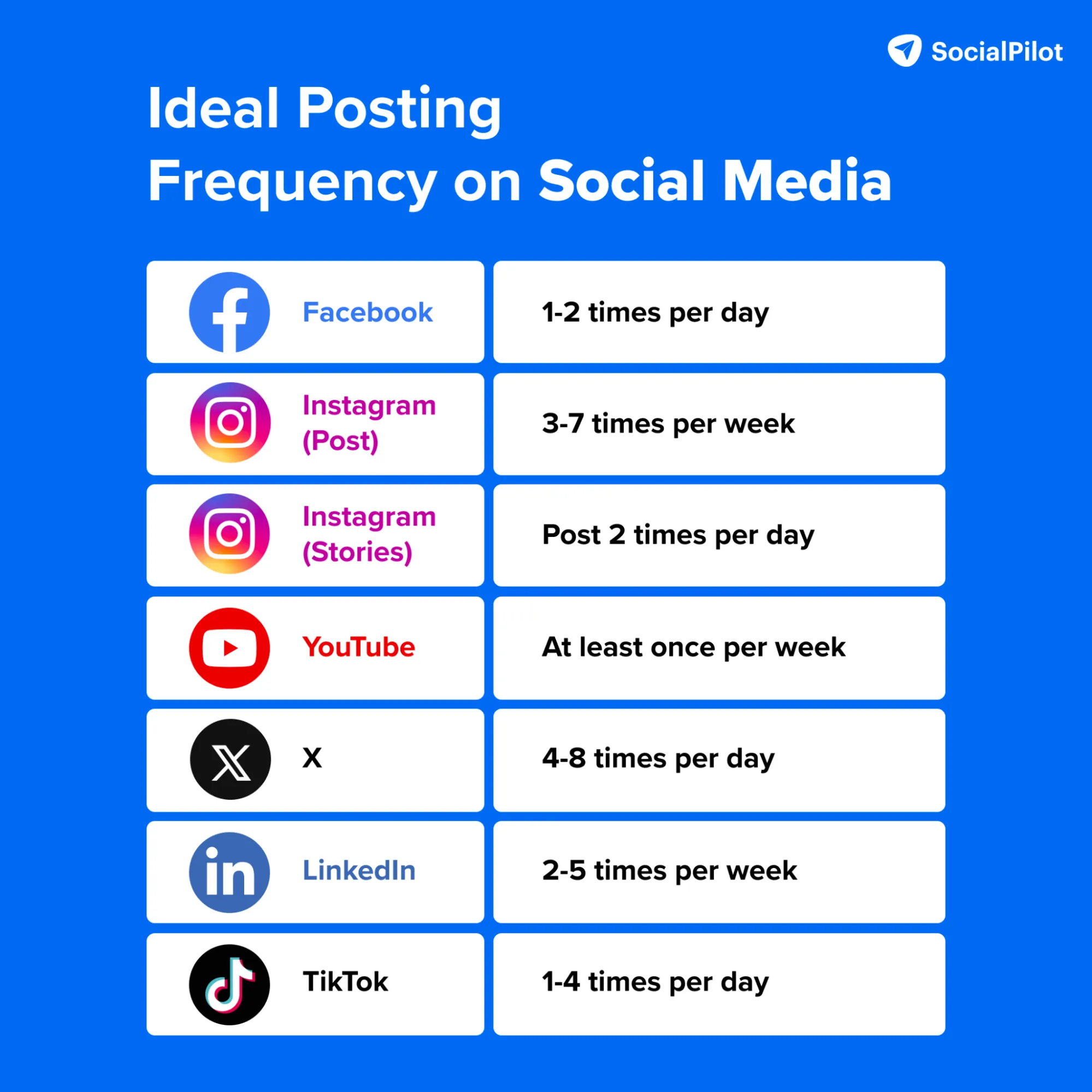
With unique, relevant content and consistency, you can single-handedly ensure continuous engagement.
10. Team Collaboration & Approval-On-The-Go
The newest innovation of complex social media marketing is implementing tools and processes that enable team collaboration and approval to streamline workflow and improve efficiency.
Effective collaboration allows the team to come together and work to complete their task within the deadline. At the same time, swift approval processes reduce the delay time caused by back-and-forth communication between the client and team. This strategy is especially effective when the team and clients are not under the same roof or located remotely.
To promote smooth workflow and speed up the process, brands use social media management tools like SocialPilot. These tools come with features like Team Collaboration and Approval-on-the-go. They help you stay connected and organized anywhere and anytime on any device.
11. Prepare for Crises
One of the most important social media best practices is to stay alert in case of errors, which brands often overlook. Social media is an ever-evolving domain, and with every minor change in the mechanism, you might have to alter your strategy, too. So, having a plan for when your prior plan fails is essential.
To manage any unexpected negative situation that is affecting your brand is your crisis management. It helps you respond quickly and effectively to reduce the damage to your brand’s reputation and keep your audience’s trust. Having a plan for a crisis situation is especially necessary when you are planning to post something new that has the potential risk of backfiring.
Here are some tips to prepare for social media crises and protect your brand image:
- Audit your posts and campaigns to identify any potential risks that can impact the brand.
- Consult your legal team, PR team, and stakeholders before you share something strong or statement-worthy on social media.
- Always have a diplomatic response plan that can restore your brand image to neutral and take responsibility for any harm it may have caused.
- Remember, social media is a place of millions of opinions. Sometimes, not taking them seriously is an act of crisis management.
By staying on top of effective crisis management, see how KFC responded to their chicken shortage crises by quickly acknowledging the issue and transparently communicating to the customer with a little humor defused.
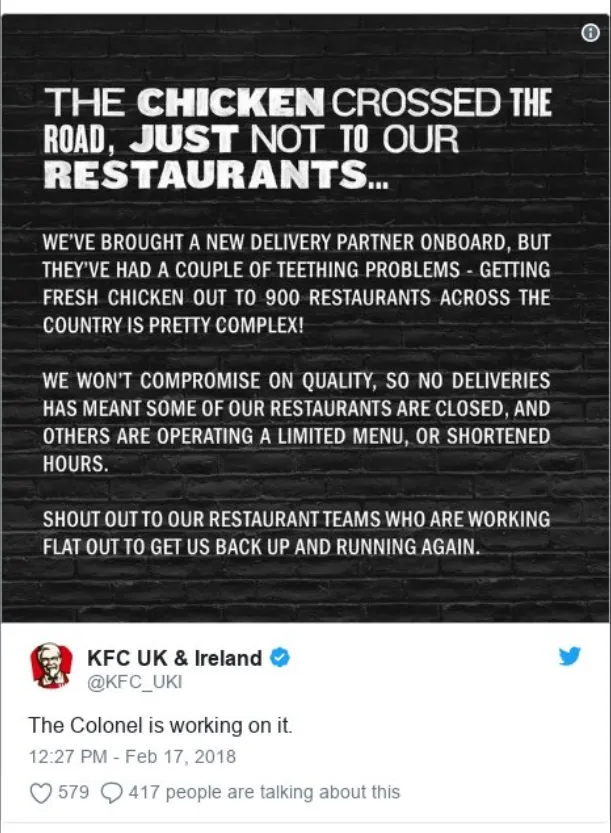
More than half of the crises can be resolved just by communicating the real side of the story to the audience.
12. Automate Your Social Media Activities
If you want to automate your social media activities, you have to utilize automation tools. These tools work as an all-rounder for your social media, from scheduling, managing interactions, and analyzing, which reduces manual efforts during busy periods or off-hours.
Even though automation is a continuous process, you can employ an automation tool as soon as your social media strategy is in place to ensure consistency and improve efficiency. As your analytics and performance change, you can also optimize your automation processes.
SocialPilot is the Best Social Media Automation Tool. It streamlines your tasks and manages your brand’s social media presence. From Scheduling and Publishing to engagement and Collaboration and Monitoring, SocialPilot is feature-packed with everything you need.
Take a Free Trial Today!
Social Media Practices for Adapting to Innovation and Technology
After adapting to smart planning, monitoring, optimization, and operations, it’s time to adapt to social media innovation and technology. This is one of the best practices for social media, which works wonders for brands and keeps them on top of their social media strategy.
13. Use Targeted Hashtags
On social media, Hashtags (#) are used as keywords or phrases to categorize content and amplify it on different platforms. Implementing a smart hashtag strategy for your posts can increase their reach and engagement in your preferred niche.
Along with using hashtags strategically, you must also update your strategy periodically based on trends, performance, and campaigns. This way you can get your brand and content discovered by the audience which are looking for any specific topic.
Regarding hashtags, brands, and marketers often fall into the myth that “more hashtags mean more reach.” Well, just using every possible hashtag related to your niche is not recommended. Instead, on several platforms, engagement reduces when the number of hashtags is greater.
See how the engagement is affected by hashtags on X (formerly Twitter)
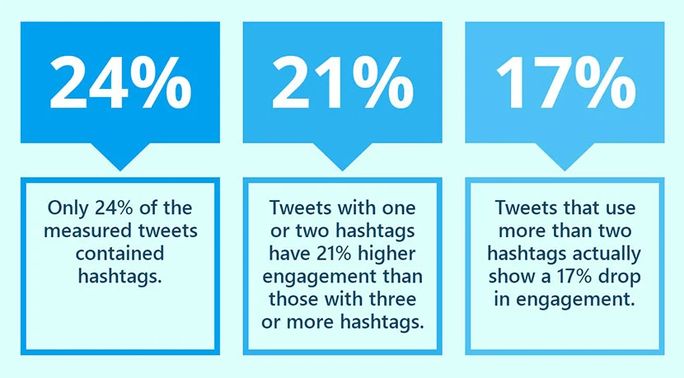
Just like Twitter, every platform has its own guidelines for hashtag usage. So, make sure you keep them in mind as you prepare your strategy.
14. Leverage Video Marketing
The Cisco Visual Networking Index predicts that in 2024, videos will make up more than 80% of the world’s internet traffic. This means that video content will be the most preferred type of content in 2024, something you might want to leverage.
Including video marketing in your social media strategy means sharing videos about your brand, products, and services. Some of the most preferred types of videos are tutorials, how-tos, vlogs, product videos, etc. Creating and sharing more videos increases engagement and is most liked by the target audience. Yes, that’s right! In their busy schedules, they never miss an interesting video.
Videos are a highly interactive way to convey complex messages and build a stronger connection with the audience. Plan your content strategy for videos to keep it fresh and engaging. The chart below shows that Videos are the most popular content type on social media, as 81% of people prefer to see video content, and 68% prefer images.
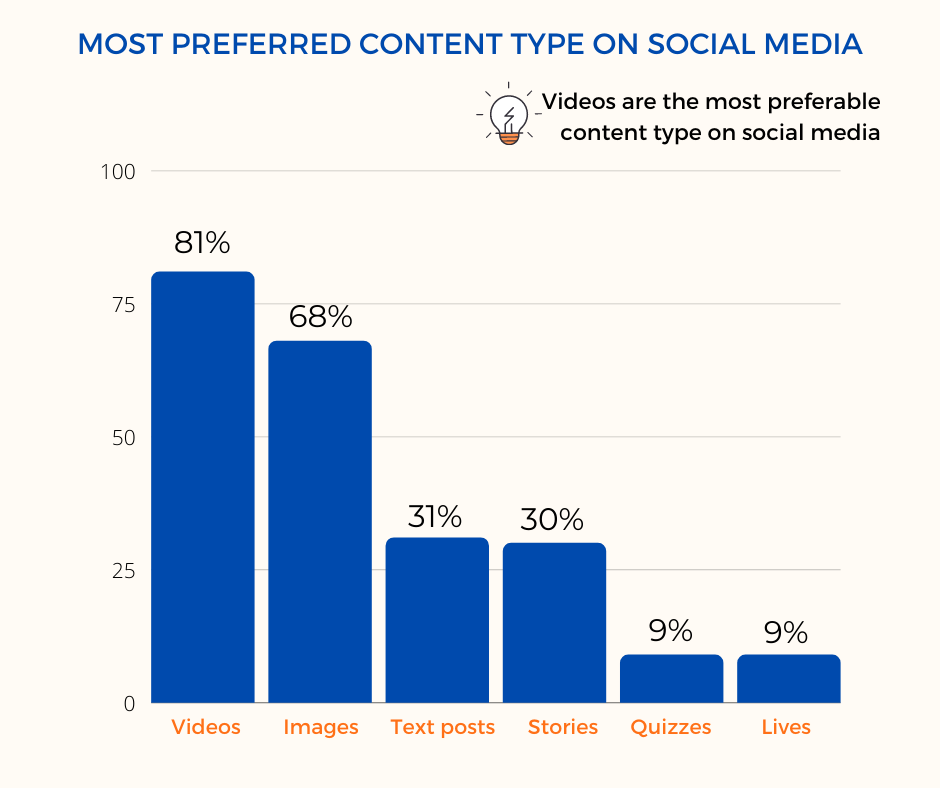
Videos are the most effective way to drive conversion and form a stronger connection with viewers. They are especially beneficial for promoting products through review videos or showcasing them in action. If you haven’t tried video marketing, make engaging videos that resonate with your target audience and start scheduling them.
15. Stay Updated on Trends
Just like every social channel is growing, social media trends are also evolving. Staying updated on trends means keeping track of the latest news and current happenings and knowing how to use that information to your personal benefit on social media.
Having a space for trending content on your schedule works best when a new trend is rolled out overnight. This way, you can benefit from the opportunity and stay ahead of the competition. This requires you to monitor changing trends and fix your strategy as needed continuously.
Some tips on how to always know what’s trending:
- On social media and the internet, follow industry leaders and experts who are more likely to share insights on anything changing.
- Be a part of online forums, communities, and groups related to social media marketing to get the information first.
- Use tools to stay updated on the trends, such as Google Trends, BuzzSumo, etc.
- As a social media marketer, you can attend webinars, workshops, and conferences to learn about the latest trends.
- Spend time on muntiple social media platforms and experiment with anything that you find relevant to your brands.
New trends are introduced every year, every month, and every week. You can start by exploring social media trends for 2024 and setting your strategy to grow faster.
Social Media Best Practices for Great Customer Services
Social media is not just a place for engaging content and attracting more followers; it is also a place to ensure great social media customer service. This is among the most important social media best practices for keeping customers happy.
Not only that, but it is also a place where customers often come with their queries, which are not resolved by customer care service. The chart below shows that over half of the consumers engage with brands on social media about customer care concerns.
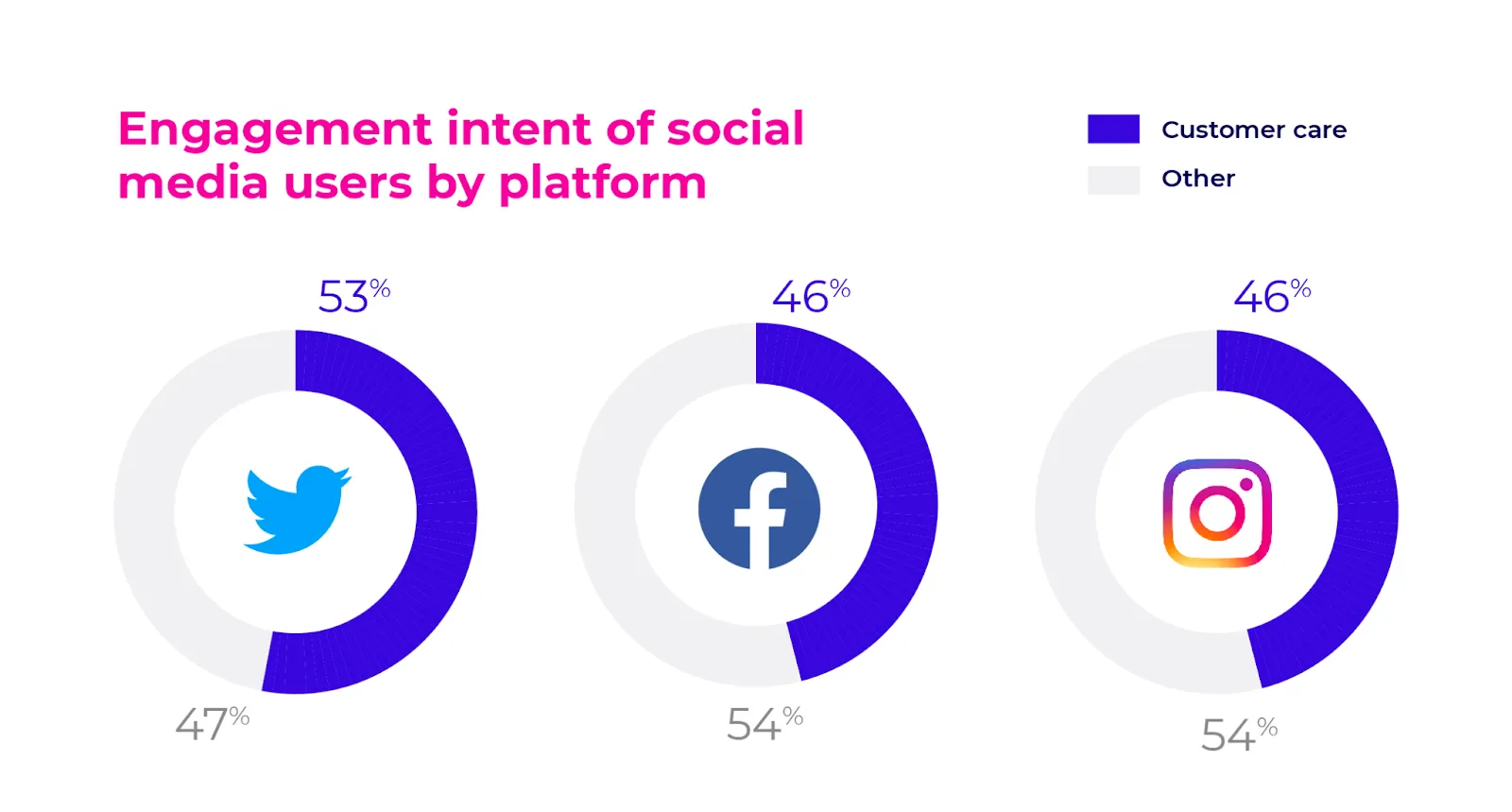
To improve your customer service on social media, you can follow these strategies:
16. Employ Chatbots
It is not possible to respond to all social media queries on all platforms unless you have a dedicated response team. This is where having a chatbot integrated into multiple social media platforms helps. It provides around-the-clock service for any customer’s queries. According to Gartner, Chatbots can become the primary channel for customer service by 2027.
Having a chatbot has several benefits:
- 24/7 Availability
- Instant Response
- Order without Human Touch
- Omi-Channel
- Personalization
- Multilingual
- Consistency in Answers
- Professional and Unbiased Conduct
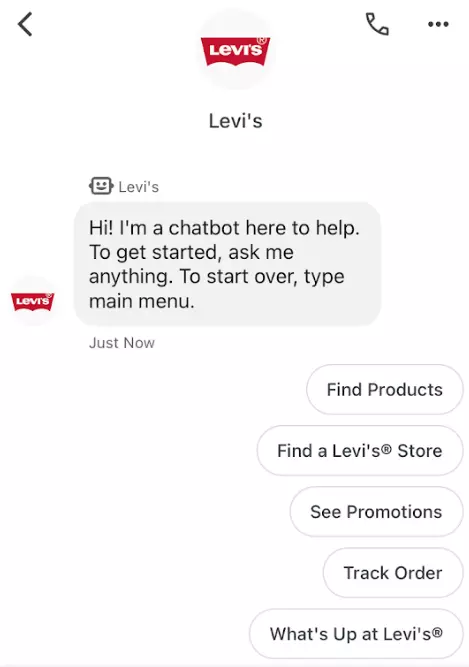
This is a chatbot integrated by Levi’s on Instagram that responds to customers in real-time and gives suggestions for further queries.
Having a chatbot especially benefits during off-hours and for being a neutral customer support representative. Chatbot enhances the customer experience by reducing the response time and freeing up human resources for more complex tasks.
Or your brands can implement a tool to streamline communication on all social channels. With SocialPilot’s Social Inbox feature, you can centralize messages and comments from all social media platforms to make it easier to manage and respond timely.
17. Develop a Response Template Library
Having a response template library ready is like creating a manual chatbot. It is a collection of pre-written replies for common queries customers ask on social media. It saves time and ensures that you have consistent and professional communication.
If your brands have a continuous template, you will provide a consistent and efficient social media customer service experience. These response templates should be implemented across all social media channels and wherever marketers respond to customers.
You can create your own social media response templates following these:
- Identify the most frequent queries and issues that customers have raised on social media.
- Develop a template with clear, direct, concise, professional responses to common queries.
- Make sure to customize and personalize these responses based on the product category and customer.
- Regularly analyze how well these responses are able to satisfy the customers and update as needed.
While creating a template, you make sure to add fields that can help others understand when to use certain responses.
- Content type (positive/negative)
- Situation (Order late, Broken item)
- Topic (pricing, customer support, contact sales, product availability)
- Lever of urgency
- Example of query
- Response copy
You can prepare multiple responses for the most frequently asked query or comment and enhance your social media customer service.
18. Use Automated Responses for Common Queries
Automated responses are pre-prepared and pre-programmed replies to some common customer queries your brand gets on social media. This can be done through a chatbot or with social media platform-integrated quick replies.
You can set them up manually on social platforms for direct messages, stories, etc. Platforms like Instagram have built-in auto-reply/saved-replies features for responding to your brand’s DMs. You can also set up welcome messages and thank you replies to automate your responses.
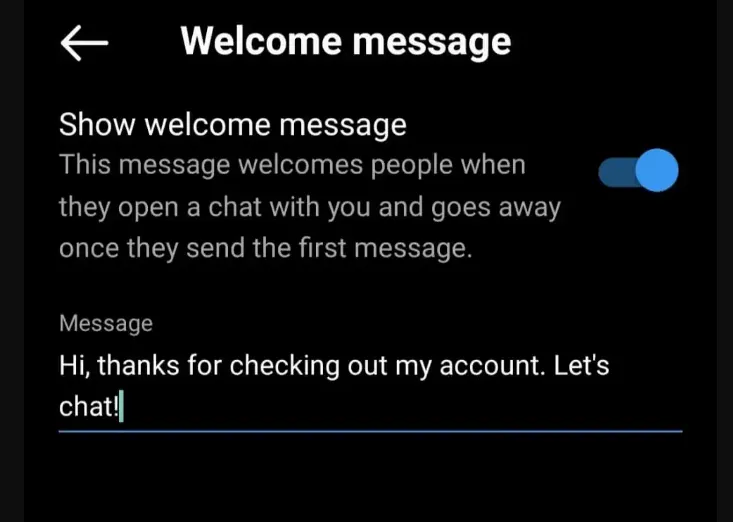
A simple strategy to prepare automated responses for your brands is:
- Identify common queries your customer asks.
- Prepare responses to answer them professionally.
- Integrate them on social platforms’ quick replies.
Having an automated response to queries can help customer satisfaction by providing them with quick solutions.
19. Measure Customer Satisfaction
Did you know? 32% of consumers abandon their favorite brand after a single bad experience. This means that even if your brand and products are loved a lot by your customers, not giving them a good customer service experience can make them drop you off their wishlist.
Social media is a great place to satisfy customers and also evaluate your CSAT (customer satisfaction) score. Several brands using Twitter for customer service see a 19% increase in their customer satisfaction. Measuring how happy your customers are with your brand and products means you can reflect back and prepare better for the future.
To measure the CSAT of your brand, you can implement these ideas:
- Conduct surveys or polls on social media, newsletters, and your website.
- Use social media analytics like SocialPilot to monitor the sentiment and response of your audience.
- Analyze their response to your solutions, if they are satisfied or leave with frustration unsatisfied.
Below is a sample of the customer service satisfaction survey form.
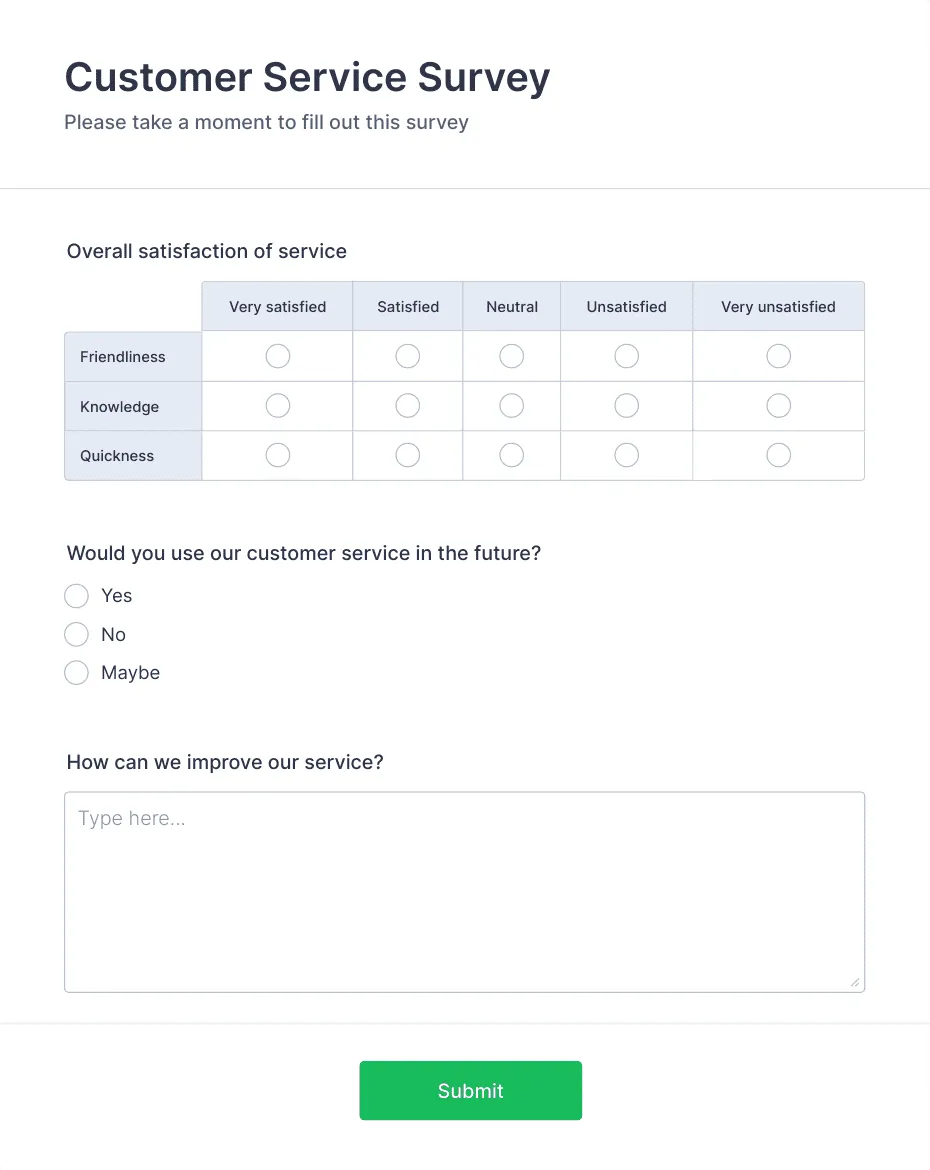
This way, you can actually stay ahead, prevent negative breakouts before they occur, align your social media efforts with your business objective, and continuously improve.
Looking Ahead
Social media is a dynamic world where no one stands still. As platforms evolve, trends change, technology adapts, and satisfaction shifts, the only way to stay consistent with your growth is to implement best practices for social media that promise success.
In 2024, you have to push boundaries and reach the fullest potential in strategic planning, content, engagement, operations, innovation, and customer services to experience the desired results. These 19 social media best practices cover all that and more. Each practice is crafted to keep you as a frontier and lead the change.

